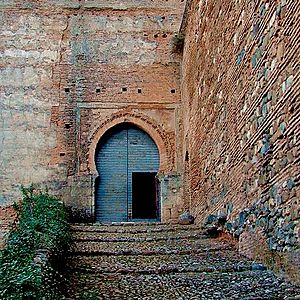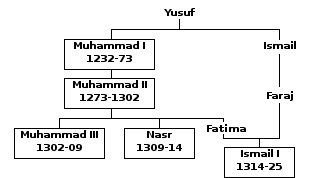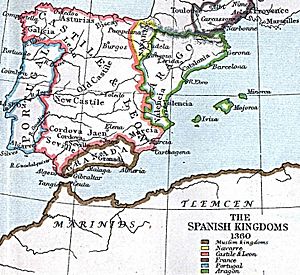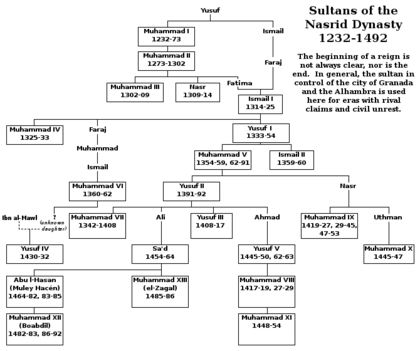Ismail I of Granada facts for kids
Quick facts for kids Ismail I |
|||||
|---|---|---|---|---|---|
| Sultan of Granada | |||||
| Reign | February 1314 – 8 July 1325 | ||||
| Predecessor | Nasr of Granada | ||||
| Successor | Muhammad IV | ||||
| Born | 3 March 1279 | ||||
| Died | 8 July 1325 (aged 46) The Alhambra, Granada |
||||
| Issue | Muhammad IV, Yusuf I, others | ||||
|
|||||
| Dynasty | Nasrid | ||||
| Father | Abu Sa'id Faraj | ||||
| Mother | Fatima bint al-Ahmar | ||||
| Religion | Islam | ||||
Abu'l-Walid Ismail I ibn Faraj (born 3 March 1279, died 8 July 1325) was the fifth ruler of the Emirate of Granada from the Nasrid dynasty. He ruled from 1314 to 1325 in a region of the Iberian Peninsula that is now part of Spain. Ismail I was a grandson of Sultan Muhammad II and is remembered by historians as a skilled and effective leader. His military victories helped make his kingdom stronger.
Ismail I became sultan after a rebellion against his uncle, Sultan Nasr. Ismail's father, Abu Said Faraj, led the rebellion. Their army defeated Nasr, and Ismail was named the new sultan in the famous Alhambra palace in February 1314.
The first few years of his rule were spent in conflict with Nasr, who tried to take back the throne from the city of Guadix. Nasr asked for help from the Christian Kingdom of Castile. This led to a major conflict that ended with the Battle of the Vega of Granada on 25 June 1319. Ismail's army, led by the general Uthman ibn Abi al-Ula, won a great victory. The two Castilian leaders, Infante Peter and Infante John, died in the battle. This left Castile without strong leaders and forced them to stop helping Nasr.
After this victory, Ismail captured several castles on the border with Castile between 1324 and 1325. During this time, his army was one of the first in Europe to use cannons in battle. Sadly, his reign ended when he was killed by a relative on 8 July 1325 over a personal disagreement. During his life, Ismail I ordered the construction of new buildings in the Alhambra and Generalife palaces.
Contents
Family Background
Ismail I was born into the royal Nasrid dynasty. His mother, Fatima bint al-Ahmar, was the daughter of Sultan Muhammad II. This made him the nephew of the two sultans who ruled before him, Muhammad III and Nasr. His father, Abu Said Faraj, was also a member of the royal family. Because of his parents, Ismail had a very strong claim to be the ruler.
The Emirate of Granada was the last Muslim kingdom on the Iberian Peninsula. It was located between two powerful neighbors: the Christian Crown of Castile to the north and the Muslim Marinid Sultanate in Morocco. The rulers of Granada had to be clever in both war and diplomacy to keep their kingdom independent.
How Ismail Became Sultan
Ismail's uncle, Sultan Nasr, was not a popular ruler. Many people at court did not like him or his main advisor, Ibn al-Hajj. They were also seen as being too friendly with the Christian kingdom of Castile.
Seeing that Nasr was unpopular, Ismail's father, Abu Said Faraj, started a rebellion in 1311. He wanted to make his son, Ismail, the new sultan. At first, the rebellion did not succeed. But opposition to Nasr continued to grow.
Later, Ismail restarted the rebellion with help from his mother, Fatima, and a military commander named Uthman ibn Abi al-Ula. This time, they were successful. As Ismail's army marched toward the capital city of Granada, more and more people joined him. The people of Granada opened the city gates for him.
Nasr was trapped in the Alhambra palace. He asked Castile for help, but it did not arrive in time. In February 1314, Nasr agreed to give up the throne. Ismail became the new sultan. Nasr was allowed to move to the city of Guadix and rule it as a governor.
Reign as Sultan
Defending the Throne
The first years of Ismail's reign were difficult. The former sultan, Nasr, still wanted to be king and ruled Guadix as his own small kingdom. He asked the Crown of Castile for help to get his throne back.
Castile agreed to help Nasr and sent an army into Granada. This led to several battles. In 1316, a Castilian army defeated Ismail's forces and captured some castles. Ismail had to agree to a truce, or a temporary peace.
The fighting started again in 1319. The two regents (temporary rulers) of Castile, Infante Peter and Infante John, led a large army to attack Granada.
The Battle of the Vega of Granada
On 25 June 1319, the Castilian army was near Granada. Ismail's general, Uthman ibn Abi al-Ula, launched a surprise attack. The battle that followed is known as the Battle of the Vega of Granada.
It was a huge victory for Ismail's army. Both Infante Peter and Infante John died during the battle. With their leaders gone, the Castilian army fell into chaos and retreated. This victory was very important for Ismail. It ended the threat from Castile and secured his position as sultan.
A Stronger Kingdom
After the Battle of the Vega, Ismail's kingdom was much safer. In 1320, he signed a peace treaty with the border towns of Castile. When Nasr died in 1322, Ismail took control of Guadix, uniting the kingdom under his rule.
With his kingdom secure, Ismail went on the attack. In 1324 and 1325, he captured several important border fortresses from Castile, including Baza, Orce, and Huéscar.
The First Cannons in Spain
During the siege of one of these towns, Ismail's army used a new and powerful weapon: the cannon. This was the first time cannons were used in a war on the Iberian Peninsula. An old text says the weapon fired an iron ball and made a "thunderous noise." This new technology helped scare the defenders into surrendering.
A Strict Ruler

As a ruler, Ismail was known for being very religious and strict. He made sure that Islamic laws, known as Sharia, were followed closely. He also had many skilled people to help him govern. His royal secretary was the famous poet Ibn al-Jayyab. His mother, Fatima, also continued to be an important advisor.
Sudden Death
Ismail's reign came to a sudden end on 8 July 1325. He was attacked and killed by his own cousin, Muhammad ibn Ismail, in the Alhambra palace. Historians from that time wrote that the two had a personal argument.
After Ismail's death, his vizier (chief minister) and his mother, Fatima, made sure that his ten-year-old son, Muhammad, became the next sultan. He ruled as Muhammad IV.
Ismail was buried in the royal cemetery of the Alhambra.
Legacy
Ismail I is remembered as one of Granada's most successful rulers. His military victories made the kingdom stronger and safer. He was also a great builder who added beautiful new sections to the Alhambra and Generalife palaces.
His use of cannons was a major change in warfare in Spain. After Ismail, his sons Muhammad IV and Yusuf I became sultans. The line of rulers that started with him is often called "the Nasrid dynasty of Ismail." Historians see him as a strong and effective leader whose life was cut short.
See also
 In Spanish: Ismaíl I de Granada para niños
In Spanish: Ismaíl I de Granada para niños







